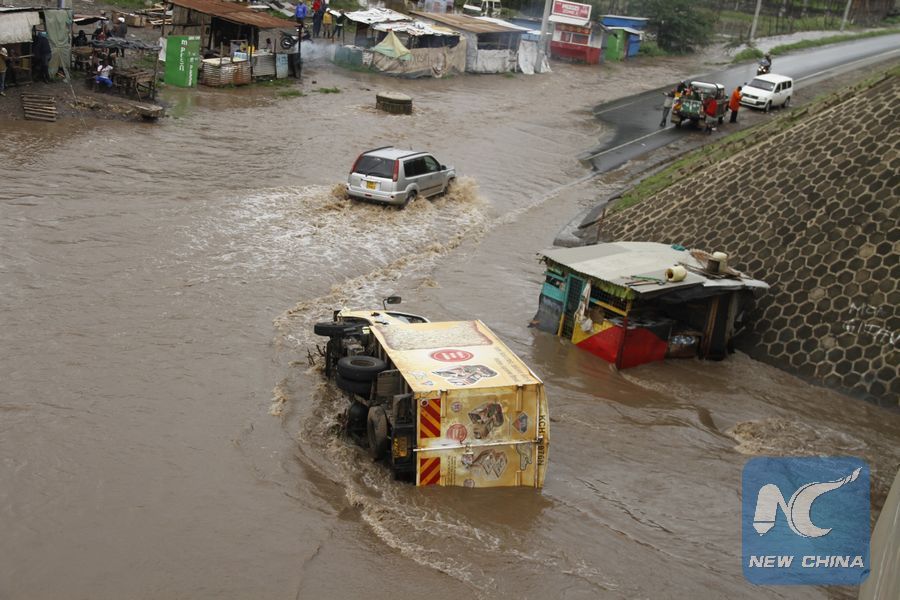
Photo taken on April 24, 2018 shows a submerged vehicle in Nairobi, capital of Kenya. (Xinhua/Fred Mutune)
NAIROBI, May 8 (Xinhua) -- Kenya could be staring at a health crisis as raging floods that have wreaked havoc in many parts of the country threaten to unleash a wave of communicable diseases like cholera, typhoid, malaria and flus.
The Ministry of Health and relief agencies have sounded alarm over possible disease outbreaks in low lying parts of the country and major cities grappling with the extreme weather event.
So far, the Ministry of Health has directed county governments to allocate funds toward mitigating the outbreak of water-borne diseases in the light of flooding occasioned by heavy downpour.
The Kenya Red Cross in its latest briefing revealed that 112 Kenyans had died as a result of floods since mid-March when the long rains began.
Abbas Gullet, the Secretary General at Kenya Red Cross, said at a media briefing on Friday that an estimated 260,000 people displaced by floods were staring at risk of vector borne diseases in the absence of urgent interventions.
"We are monitoring the situation in the camps for people displaced by floods to ward off disease outbreaks. Our volunteers have been providing purification gadgets in flooded regions to keep water-borne diseases at bay," said Gullet.
The Kenya Red Cross has already made a 5 million U.S. dollar appeal from local and foreign well-wishers to strengthen provision of emergency assistance to 150,000 flood victims in the western, northeastern and coastal regions.
Gullet said the bulk of the money will be earmarked for supply of food, clean drinking water and medical kit to families marooned by floods in low lying Kenyan plains.
"Our immediate areas of intervention include supply of water treatment chemicals to prevent a cholera outbreak in flooded regions," said Gullet, adding that flood victims will also be supplied with mosquito nets to minimize the risk of contracting malaria.
Kenya and its neighbors in the greater eastern African region such as Rwanda and Somalia have been experiencing above normal rainfall accompanied by flash floods.
The three countries have attracted international media spotlight as heavy flooding continue to terminate lives while destroying transport, power and communications infrastructure as well as hospitals and schools.
This phenomenon that is linked to climate change has in particular cast a dark shadow on Kenya's quest to achieve food security after a prolonged drought season.
Nevertheless, both the central government and relief agencies have scaled up emergency interventions in regions affected by flooding to prevent a humanitarian crisis.
Eugene Wamalwa, Cabinet Secretary for Devolution and Planning, has been overseeing efforts to rescue communities marooned by floods and relocate them to safer grounds.
During a recent tour of the epicenter of flooding in the coast region, Wamalwa said the government had set aside adequate funds to cater for food, shelter, clean water and medical services to flood victims.
"The government has mobilized funds, personnel and equipment to ease suffering of people affected by floods. We are aware that many schools and hospitals have been submerged thus denying essential services to flood victims," Wamalwa said during a visit to the coast region.
Counties affected by floods have intensified surveillance to prevent an outbreak of vector-borne diseases that could place enormous strain on public healthcare infrastructure.
Local media reports indicate that counties in western Kenya and the coast region have sought additional financial support from the central government and relief agencies to procure essential drugs and promote environmental hygiene in the wake of heavy flooding.
Health officers in the coastal city of Mombasa have been educating communities on necessary measures in order to avoid contracting vector borne diseases like malaria and chikungunya.
The risk of water-borne diseases also looms large in western Kenyan counties thanks to destruction of sanitation facilities by storm waters.
As floods destroy healthcare facilities in remote Kenyan counties, the spread of infectious diseases could escalate in the absence of strong deterrent measures.

